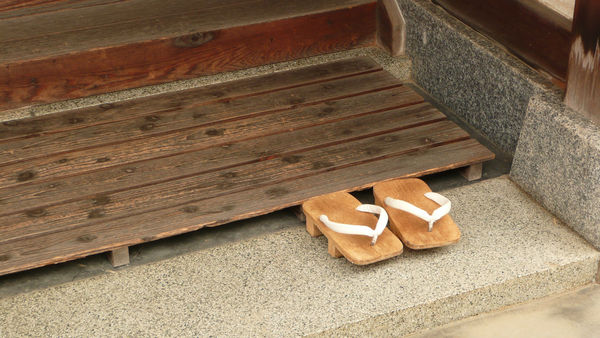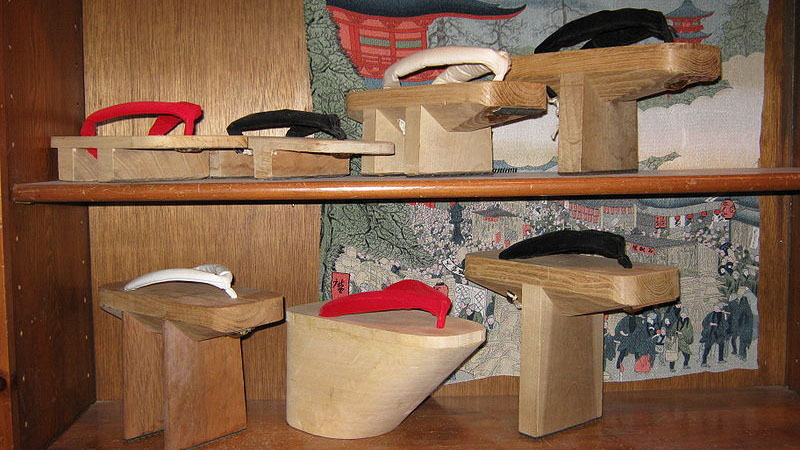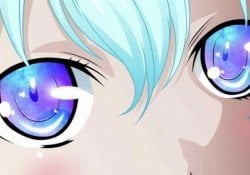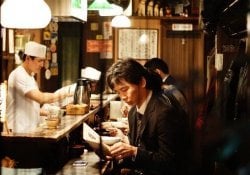You've probably seen someone wearing a geta – wooden shoes, even in movies. Ever wondered why? What is the need? What is it for? In this article we will clear all these doubts.
Geta [下駄] is considered a sandal, with a wooden base, similar to a clog, it serves to prevent the foot from contacting the ground. They are worn with traditional Japanese clothing, such as kimono or yukataor during the summer months.

Índice de Conteúdo
What is Geta for?
His goal is to prevent the foot from coming into contact with the snow or rain and to keep the foot dry, it also prevents the kimono from dragging on the ground. In its simplest form, geta is a thick wooden sandal supported by a single piece of wood. The wooden bottom piece is called the "teeth".there is [歯]). Using with just 1 tooth requires a lot of balance, so today most have 2 teeth.
Geta are typically only worn with yukata or other casual clothing, there is no need to wear socks, in some more formal cases where kimono are preferred, they are worn sandals zori made from rice straw or other fibers.

The reason for using these high platform shoes is not because of fashion, but for practical reasons. If you wear an expensive kimono, you wouldn't want to get it dirty with mud.
Curiosities involving Geta
Karankoron - Geta makes a noise when you walk. In the Japanese language, this sound is called "karankoron".
Geisha - At geisha and maiko (apprentices) often wear a type of geta called okobo (or "pokkuri" and "koppori"), okobo are very tall and usually made from a block of willow wood rather than having teeth.

Breaking the wire - Breaking the geta thread is considered bad luckFor this reason, many people avoid buying cheap shoes, but they are surprisingly easy to break. It is still possible to find places to repair them when broken.
Tetsugeta - They are iron getas, which weigh from 3 to 5 kilograms. They were historically used by students of martial arts like karate, to strengthen the legs.
Types of Geta
There are different types of geta, are usually categorized by some special feature in each of them. Now let's list the existing Japanese clog types:
Ashida [足駄] - High clogs; rain clogs;
Yamageta [山下駄] – Geta of the mountains, raw geta, usually made of Japanese cedar;
Kōshi [厚歯] – Clogs with thick teeth in the anterior-posterior direction. Called Bunkara by some students.
Yanagigeta [柳下駄] - low geta made from willow.
Umageta [馬下駄] – ancestor made of cedar with different teeth and square. Similar to a horseshoe.
Komageta [駒下駄] – a clog that can be worn in any weather. Introduced in the late 17th century and widely used. for all.
Kirigeta [桐下駄] – Initially painted black, it was used as a deluxe item;
Tetsugeta [鉄下駄] - Iron clogs instead of wood.
Takageta [高下駄] – Tall clogs with long teeth in the vertical direction.
Tagette [田下駄] – The oldest footwear in Japan, which was extracted from remains of the Yayoi period. They are believed to have been used in rice plantations and swamps.
Ipponba [一本歯] – Used for walking in mountains, used by monks who practiced in the mountains. It is said to be the origin of the tengu also called tengu clog.
Yoshiwarageta [吉原下駄] – Almost the same as Yamashita, but made of cedar. The thong is made of bamboo skin.
Sukerokugeta [助六下駄] - The clog the main character is wearing in Kabuki 18 "Sukeroku". It became popular at the time of its debut (1713).
Ukongeta [右近下駄] – A toothless obstruction with a curved surface. The area around the foot is excavated.
Hiyorigeta [日和下駄] - geta to use in dry weather.
Toshihisageta [利久下駄] - Senrikyu is said to have invented it.
azumaget [吾妻下駄] – type of geta for women with tatami insole.
Nikkōgeta [日光下駄] - Traditional from Nikko.
Odawarageta [小田原下駄] – From Odawara, the roots of the teeth do not show and can be replaced.
Shinshoku-yō geta [神職用下駄] – White synthetic leather round clogs worn by priests.
Pokkurigeta [ぽっくり下駄] – It got its name because of the sound, they are used by geisha and maiko.
Getasukēto [下駄スケート] - geta with skating blades.
robbed [露卯] – Clogs with different teeth, where you can see the hozo of the teeth on the table.
Hachitsuwari (yatsuwari) [八ツ割(ヤツワリ)] – Clog without teeth.
The article is still halfway through, but we recommend also reading:
Videos about Geta
To wrap up the article, I'll leave a video for you to see the sound that the geta makes, how to use it and walk with it. See that it's not a big deal.






